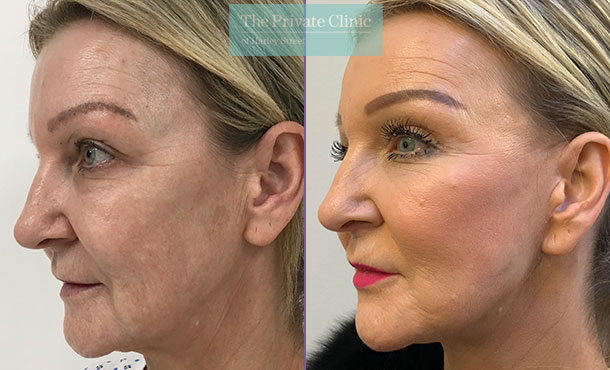
Facelift Recovery: What to Expect & How to Heal
A facelift is an excellent procedure for restoring a youthful appearance by tightening loose skin and rejuvenating facial contours. At The Private Clinic, we understand that recovering from a facelift is just as important as the procedure itself.
Whether you’re planning your surgery or preparing for recovery, this comprehensive guide covers the facelift recovery timeline from Day 1 to Day 30, including essential tips and what to avoid during healing to ensure a smooth, effective recovery.
What is a Facelift?
A facelift, or rhytidectomy, is a cosmetic surgery designed to address signs of ageing, such as sagging skin, deep wrinkles, and loss of facial volume. By tightening and repositioning facial tissues, a facelift can create a more refreshed and youthful appearance.
See more Facelift before and after photos
Facelift Recovery Timeline: Day 1 to Day 30
Recovery after a facelift unfolds in stages. Here’s a clear breakdown of what you can expect and how to manage each phase:
- Days 1-7: Initial Recovery
Initial swelling and bruising are common and may extend to your eyelids and forehead, depending on the treated areas. Rest with your head elevated, use cold compresses, and wear a compression garment at night to reduce swelling. Discomfort is managed with prescribed pain relief.
Top Tip: Arnica tablets may help reduce bruising—ask your surgeon if this option is suitable for you. - Days 7-14: Healing Progress
Swelling and bruising will start to subside, and any removable stitches are typically taken out. Mild tightness or numbness may still be present, but discomfort should be minimal. - Days 15-30: Return to Normal
Bruising should be mostly gone, and many patients feel ready to return to work and regular activities. Full sensation and natural skin tightness may take a bit longer to settle.
For an even more detailed recovery guide, visit our ‘What to Expect After a Facelift’ blog.
What to Avoid Following a Facelift
To ensure a smooth recovery, avoid the following activities:
- Strenuous Exercise: Avoid high-impact activities for 4-6 weeks.
- Smoking and Alcohol: Avoid entirely for several weeks.
- Sun Exposure: Protect your skin from direct sunlight.
- Side Sleeping: Keep your head elevated and sleep on your back.
Your Return to Daily Activities
Here’s a general timeline for resuming daily activities after a facelift:
- Desk Work: 1-2 weeks
- Physical Work: 2-4 weeks
- Light Exercise: From 4 weeks
- Full Exercise: 6-8 weeks
Facelift Recovery Tips for a Smooth Healing Process
While your body will take its natural time to heal, these strategies can support faster recovery and help you feel better sooner:
- Stay Hydrated and Maintain a Balanced Diet: Proper hydration and nutrition aid your body’s healing.
- Use Cold Compresses: Applying these in the first few days can reduce swelling.
- Follow Your Surgeon’s Instructions Diligently: Adhering to aftercare advice is key to an effective recovery.
- Rest and Elevate: Avoid overexertion, especially in the first few weeks, and keep your head elevated while sleeping.
- Wear Recommended Compression Garments: They support healing tissues and reduce swelling.
Ready for Your Facelift Journey?
With thousands of successful procedures performed and exceptional patient care, our surgeons at The Private Clinic have helped countless patients achieve natural-looking, rejuvenated results.
- Mr Dario Rochira, BS, MD. GMC Number: 6130664
- Mr Navid Jallali, BSc, MB ChB (Hons), MD FRCS (Plast). GMC Number: 4404969
- Mr Mrinal Supriya, FRCS (OTOL-HNS), MRCS Ed, DO-HNS, MS in ENT, MBBS. GMC Number: 6066456
- Ms Monica Fawzy, MBChB, MRCS, FRCS (Plast). GMC Number: 6051977
Get in touch
Find out more about our facelift treatments by calling us on 03339209135, or using our online contact form to request a consultation with our expert surgical team to discuss your facelift journey and create your personalised treatment plan.
Sources
American Society of Plastic Surgeon – Your facelift recovery explained from Day 1 to Day 30








